Travel Tips
How to Make the Most of the Summer Daylight in Alaska
With over 20 hours of daylight, summer is by far the most popular time to visit Alaska. But you can get away from the cruise ship crowds to catch the spirit of the Frontier State. From bear watching to tidepooling, contributor Kathy Jackoway shares her tips for making the most of summer daylight in Alaska.
I first traveled to Alaska to climb Mt. McKinley, and have since been back many times. I’ve never been on an Alaskan cruise, but I’ve traveled extensively by bush and float planes. But to really experience all that Alaska has to offer, you need to be prepared to drive, fly, and maybe even hop on a train or boat– and you need to be flexible.
Alaskan weather can be unpredictable. Carrying a small backpack with a few essentials—a rain jacket and a fleece, a hat, a pair of gloves, sunscreen, insect repellent and anti-nausea medication– will go a long way toward making any unexpected changes more enjoyable. If you’re armed with a good attitude and the knowledge that there’s a chance that you might need to alter your plans, you’re setting yourself up for a great adventure.
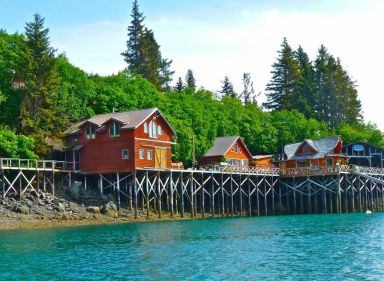 My most recent trip to the state took me to Southcentral and Southwest Alaska. I began with an eight-hour ferry ride on the M/V Kennicott from Homer to Kodiak. The Kennicott is a working ferry, shuttling not only passengers but trucks and cargo along the Alaska Marine Highway. The scheduled departure was running nine hours behind schedule, so I took advantage of the delay by hopping onto a small boat for a wildlife viewing tour in Kachemak Bay, looking for whales, sea otters and bald eagles. Our guide took us out to Gull Island, a large, terraced rock formation that is a sanctuary for 16,000 nesting birds in the summertime, and then on to Halibut Cove, a small community only accessible by boat.
My most recent trip to the state took me to Southcentral and Southwest Alaska. I began with an eight-hour ferry ride on the M/V Kennicott from Homer to Kodiak. The Kennicott is a working ferry, shuttling not only passengers but trucks and cargo along the Alaska Marine Highway. The scheduled departure was running nine hours behind schedule, so I took advantage of the delay by hopping onto a small boat for a wildlife viewing tour in Kachemak Bay, looking for whales, sea otters and bald eagles. Our guide took us out to Gull Island, a large, terraced rock formation that is a sanctuary for 16,000 nesting birds in the summertime, and then on to Halibut Cove, a small community only accessible by boat.
There are no roads in Halibut Cove, and depending upon who you ask, there are approximately 30 to 45 permanent residents, most of whom make their living as artists or commercial fishermen (or both). It’s not difficult to see why artists would be drawn to the cove. There’s inspiration to be found in every direction. It’s also home of one of the only floating post offices in the U.S. There are a number of small lodges and art galleries, and what is, by many accounts, a pretty fantastic restaurant (that we’d arrived too early to have lunch at), all connected by boardwalks.
 By early evening I was on the ferry to Kodiak, and very happy to have booked cabins in advance so that we could get some sleep before our 4 am arrival. Some of the passengers without cabins had the foresight to bring sleeping bags, and they appeared to be comfortable stretched out in the large solarium on one of the upper decks—though eyeshades are a necessity if you choose to do so, because the sky never gets much darker than dusk in the Alaskan summer.
By early evening I was on the ferry to Kodiak, and very happy to have booked cabins in advance so that we could get some sleep before our 4 am arrival. Some of the passengers without cabins had the foresight to bring sleeping bags, and they appeared to be comfortable stretched out in the large solarium on one of the upper decks—though eyeshades are a necessity if you choose to do so, because the sky never gets much darker than dusk in the Alaskan summer.
Kodiak is Alaska’s largest fishing port, and is home to over 800 commercial fishing vessels, numerous canneries and the source of countless fishing vacations. I did a short walking tour of the Kodiak Maritime Museum which was well worth the hour spent in the harbor. Our guide, Ani, was extremely knowledgeable about commercial fishing and well-versed in Kodiak’s fascinating and often tragic maritime history.
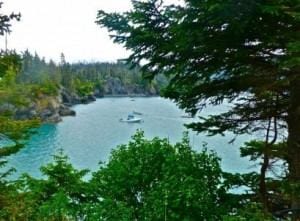 There’s some great hiking–from Fort Abercrombie State Park, which contains remnants of old World War II lookout posts– to high mountain ridges with beautiful vistas of the surrounding bays and vast green meadows filled with wildflowers. It’s important to keep in mind that when you’re hiking in Kodiak, you’re in bear country. There are 3,000 Kodiak Bears on the island, and it’s the only place in the world where they live. You don’t want to surprise a mama and her babies while you’re walking along a trail, so it’s good to remember to make noise or to bring along a bear bell. It’s also not the worst idea in the world to carry pepper spray.
There’s some great hiking–from Fort Abercrombie State Park, which contains remnants of old World War II lookout posts– to high mountain ridges with beautiful vistas of the surrounding bays and vast green meadows filled with wildflowers. It’s important to keep in mind that when you’re hiking in Kodiak, you’re in bear country. There are 3,000 Kodiak Bears on the island, and it’s the only place in the world where they live. You don’t want to surprise a mama and her babies while you’re walking along a trail, so it’s good to remember to make noise or to bring along a bear bell. It’s also not the worst idea in the world to carry pepper spray.
I didn’t actually see any bears during our stay in Kodiak, but had scheduled a bear tour once we got back to Homer. I flew to a ‘secret’ beach somewhere in Katmai National Park (so secret, apparently, that our guides from Sasquatch Alaska Adventure Company, Zack and Tim, would have to kill us if they told us). But seriously, they’d put a lot of hours into researching locations and following the habits of the bears to almost be able to guarantee that we’d find them, and Zack prides himself on the fact that the only humans these particular bears have ever seen are his pilots and his clients. He also enforces one of the strictest “Leave No Trace” policies I’ve ever come across on any wilderness adventure. He was adamant that we not introduce anything unnatural to the environment, and so insisted that any food or snacks that we ate be eaten over our open backpacks so that no so much as a single crumb fell onto the ground.
I had previously been bear viewing by boat. Seeing a bear by boat is a bit like being in a safari vehicle, or going to a wild animal theme park—it’s a tour. You’re viewing the animals up close, but with enough distance in a vehicle that, in theory, can get you away quickly and safely in the event that an animal becomes agitated. Bear viewing on foot is a much more of an adventure.
Preparation is key. We’d been outfitted with waders, and we pretty much needed them from the time we jumped off the small planes onto the beach. It was very marshy, and having waders made walking much easier. This was also the day that we learned why they call mosquitoes the state bird. Mosquito repellent was mandatory to get through the day.
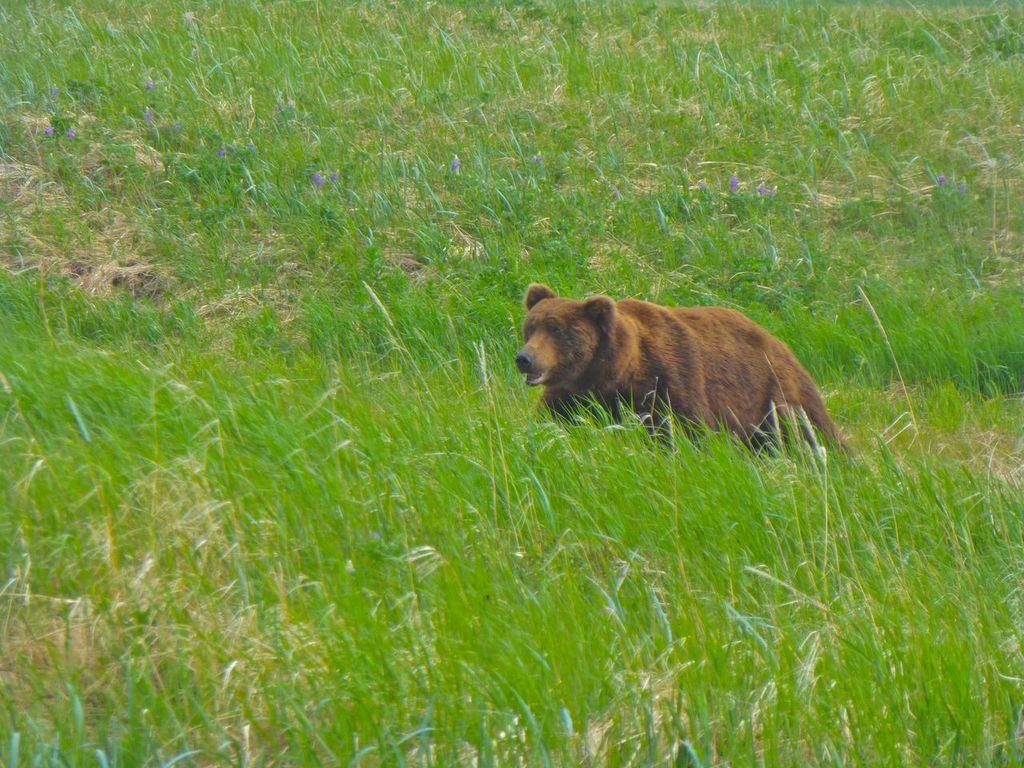 It didn’t take long to come across our first bears—a couple of male bears vying for the attention of a female who seemed to want nothing to do with either of them. We spent a couple of hours watching and following them, crossing a river (great fun with the high waders on!) and finally settling on a small bluff to observe them. Unbeknownst to us, one of the males had disappeared behind the bluff we were perched on, and when he reappeared, he was close enough for us to hear him snorting and to see his nostrils flaring. It was a little unsettling, but our guide assured us that the bear was aware of our presence, and was really more interested in finding a mate than an encounter with us. Our job was to remain calm and do nothing except watch or take photos. We did, and he continued on his way. On our walk back to the plane, we saw a mama bear with three tiny baby cubs playing along the shoreline, but this time from a very safe distance.
It didn’t take long to come across our first bears—a couple of male bears vying for the attention of a female who seemed to want nothing to do with either of them. We spent a couple of hours watching and following them, crossing a river (great fun with the high waders on!) and finally settling on a small bluff to observe them. Unbeknownst to us, one of the males had disappeared behind the bluff we were perched on, and when he reappeared, he was close enough for us to hear him snorting and to see his nostrils flaring. It was a little unsettling, but our guide assured us that the bear was aware of our presence, and was really more interested in finding a mate than an encounter with us. Our job was to remain calm and do nothing except watch or take photos. We did, and he continued on his way. On our walk back to the plane, we saw a mama bear with three tiny baby cubs playing along the shoreline, but this time from a very safe distance.
The rest of my time in Homer was spent exploring the town, eating great seafood, and browsing the many art galleries and shops before heading across the water for a night at the Kachemak Bay Wilderness Lodge in China Poot Bay.
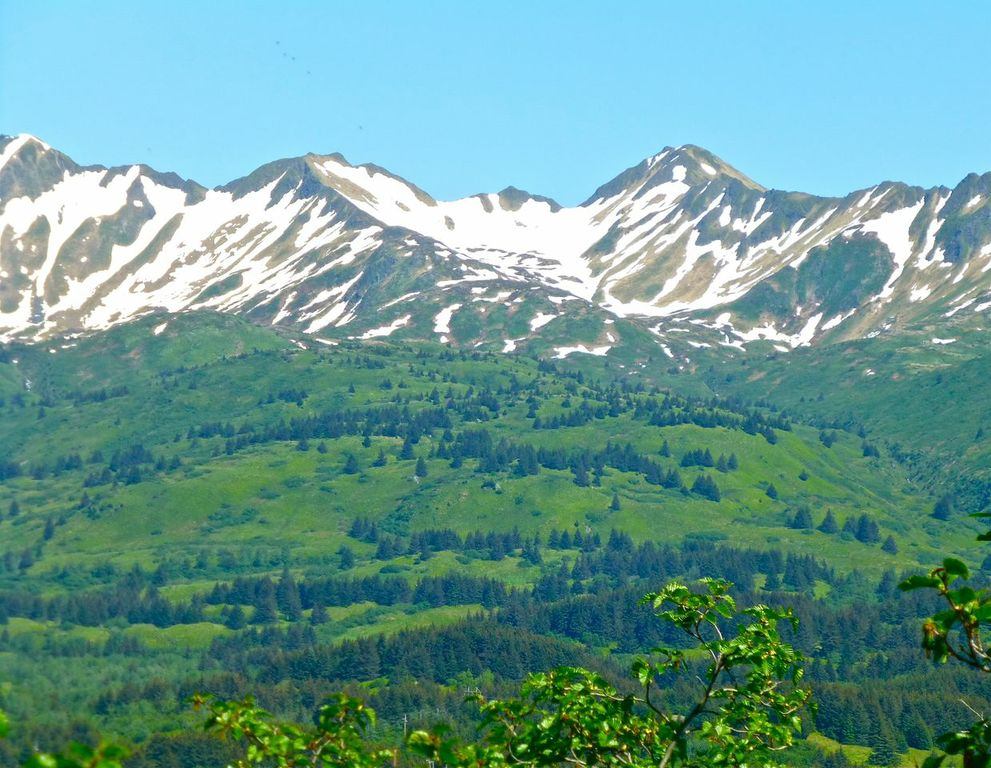 A stay at a wilderness lodge is a wonderful way to experience Alaskan hospitality at its best, and there is truly something for everyone. We spent our 24 hours at the lodge hiking, wildlife viewing, writing, taking photographs and ocean kayaking—but the real treat, to my great surprise, was tidepooling. It was an eye-opening experience to walk the wide, sandy shoreline while the tide was out with a guide who had vast knowledge of the local marine life, and to find that things that appeared to me to be nothing more than stones, or empty clam shells were actually sea life. Upon closer inspection, there were sea stars and urchins clinging to every large rock, and once you knew what to look for, nearly everything underfoot turned out to be alive or had something living underneath it. Dan, our guide, even knew where to find a Giant Pacific Octopus hiding in the rocks.
A stay at a wilderness lodge is a wonderful way to experience Alaskan hospitality at its best, and there is truly something for everyone. We spent our 24 hours at the lodge hiking, wildlife viewing, writing, taking photographs and ocean kayaking—but the real treat, to my great surprise, was tidepooling. It was an eye-opening experience to walk the wide, sandy shoreline while the tide was out with a guide who had vast knowledge of the local marine life, and to find that things that appeared to me to be nothing more than stones, or empty clam shells were actually sea life. Upon closer inspection, there were sea stars and urchins clinging to every large rock, and once you knew what to look for, nearly everything underfoot turned out to be alive or had something living underneath it. Dan, our guide, even knew where to find a Giant Pacific Octopus hiding in the rocks.
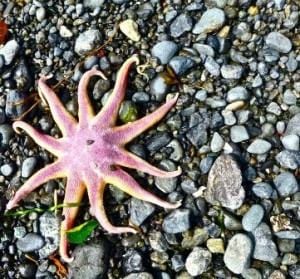 The motto on the back of Alaskan license plates is “The Last Frontier.” I’ve found that each of my Alaskan adventures and every town or village I’ve visited has provided a one-of-a-kind experience, and true to the motto, Alaska is still a place for discovery if you know what to look for.
The motto on the back of Alaskan license plates is “The Last Frontier.” I’ve found that each of my Alaskan adventures and every town or village I’ve visited has provided a one-of-a-kind experience, and true to the motto, Alaska is still a place for discovery if you know what to look for.
Many Alaskans regularly travel by small plane the way most of us in the “Lower 48” travel by car. Oftentimes a plane is the only expedient way to access areas that are remote– or places that are otherwise completely inaccessible.
For more Alaska travels, check out:
- How to Cruise with a Purpose in Alaska
- Avoiding the Big Cruise & Finding New Adventures
- Small Ship Cruising to Alaska & Beyond
By Kathy Jackoway for PeterGreenberg.com












